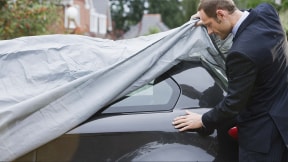Guide to pressure washing a car

Quick insights
- The lowest setting on most pressure washers may work well enough to wash your car and avoid damaging it.
- When possible, use a fan-shaped nozzle and avoid aiming directly at sensitive areas like mirrors and windows.
- Before pressure washing a car, you can contact a dealership or mechanic to see if they have recommendations for specific products or settings.
Pressure washing your car is like using a super-powered hose—but with great power comes great responsibility. Applying too much pressure might blast more than dirt and grime.
Can you pressure wash your car?
Most pressures may be used to wash cars depending on the available pressure settings. It’s worth confirming that you can pressure wash your car based on the vehicle manufacturer’s recommendation. Contact dealerships, the manufacturer itself or consult your owner’s manual before proceeding.
How to pressure wash your car
Here’s a general process you could follow to pressure wash your car:
Prep the area and equipment
Park your car in a shaded, open area; direct sunlight can dry beads of water and leave spots. Connect the pressure washer to a water source and attach a fan-shaped nozzle. Ensure the pressure is set as low as possible (you can always adjust it later).
Rinse the car
Start by rinsing the car with water to loosen dirt and debris. Keep the nozzle farther away from the surface and move in sweeping motions from top to bottom. You can adjust your distance based on your progress.
Apply soap
Use a foam cannon attachment or apply car-safe soap manually. Allow the soap to sit for a few minutes to break down grime, but don’t let it dry on the surface.
Scrub the car (optional)
For tough spots, use a soft sponge or microfiber mitt to gently scrub the car. Pay extra attention to wheels, hubcaps, bumpers and any areas with stubborn dirt.
Rinse the car again
Rinse off the soap, starting from the top and working your way down. Maintain a safe distance to prevent damaging paint or seals.
Dry the car
Use a microfiber towel to hand-dry the car and prevent water spots. If you have one, a leaf blower can help remove excess water from cracks and crevices.
Add the final touches
Check for missed spots and touch up any areas with a microfiber cloth. For extra shine, consider applying wax or sealant.
Should you pressure wash your car?
Pressure washing may be an efficient way to clean your car and remove stubborn spots. However, using too much pressure or getting too close to delicate areas can cause serious damage to your paint, windows and rubber seals.
Safety tips for pressure washing your car
- Follow the device instructions and safety warnings.
- Start with the lowest pressure setting and adjust upward if needed.
- Hold the nozzle farther away from the surface, at least at first, to avoid damaging paint or seals.
- Avoid spraying directly into sensitive areas like door seams, windows or the engine bay.
Choosing a pressure washer for cars
When choosing the right pressure for washing a car, consider products that seem on the low end in terms of PSI. Having a fine scale for making adjustments to the PSI can be helpful, too. Washers that boast high pressures are best left for cleaning concrete and home exteriors, not your car’s finish.
Consulting with dealer technicians and the manufacturer may be helpful when choosing a pressure washer and settings to use.
In summary
Pressure washing your car involves using a high-powered stream of water (and soap) to clean your vehicle’s exterior. Using the correct equipment and technique can avoid damaging your car. This might include choosing a pressure washer designed for automotive use, selecting the right nozzle and applying appropriate water pressure.
Be careful, follow any official recommendations you can get, and your car might sparkle without any battle scars.



